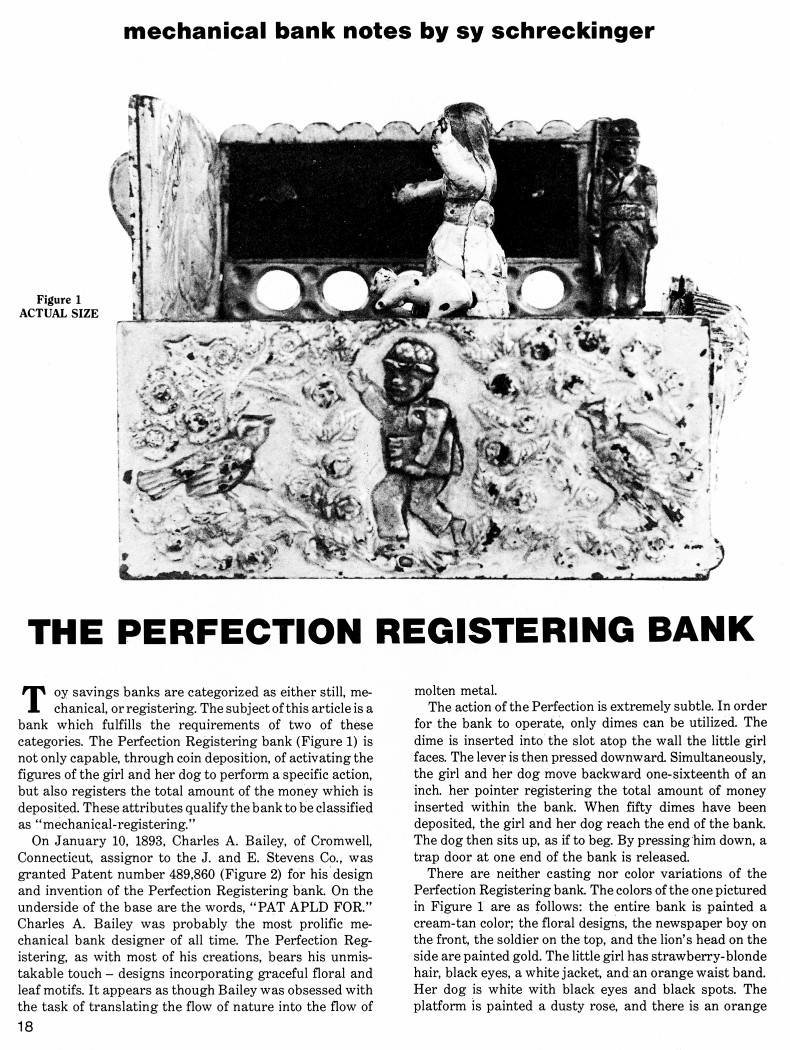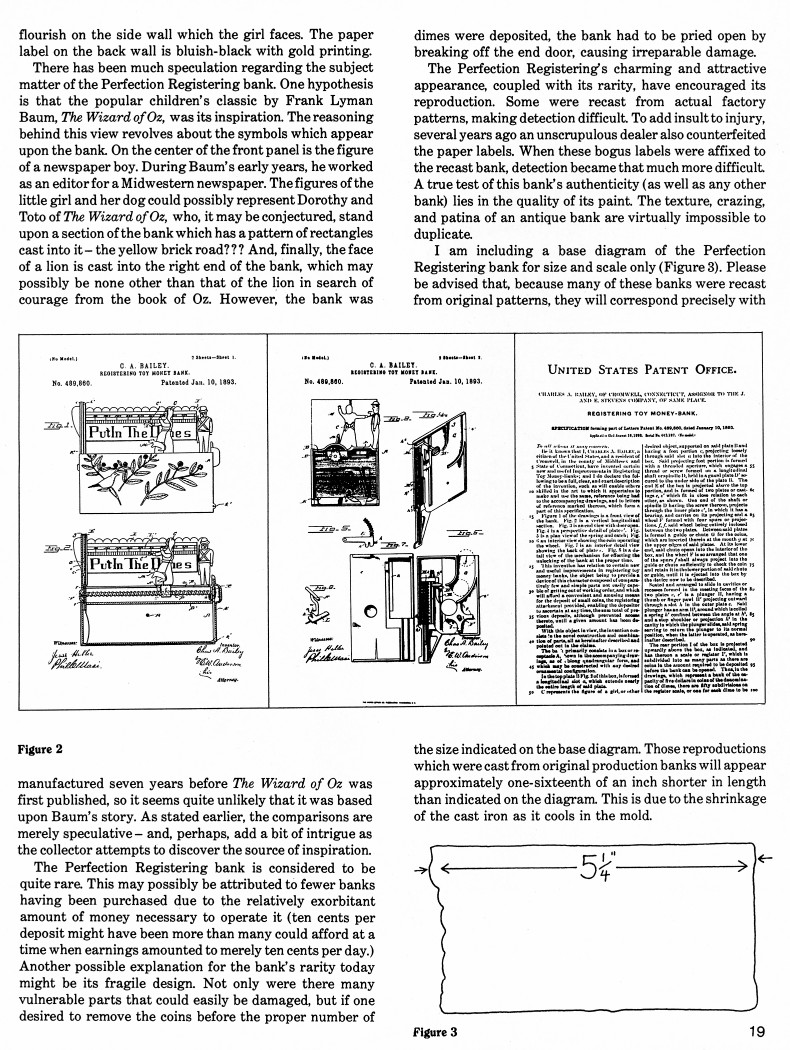|
The Perfection
Registering Bank
by Sy Schreckinger – ANTIQUE TOY WORLD Magazine – April, 1986
Toy savings banks
are categorized as either still, mechanical, or registering. The subject
of this article is a bank which fulfills the requirements of two of these
categories. The Perfection Registering bank (Figure 1) is not only
capable, through coin deposition, of activating the figures of the girl
and her dog to perform a specific action, but also registers the total
amount of the money which is deposited. These attributes qualify the bank
to be classified as "mechanical-registering."
On January 10, 1893, Charles A. Bailey, of Cromwell, Connecticut,
assignor to the J. and E. Stevens Co., was granted Patent number
489,860
(Figure 2) for his design and invention of the Perfection Registering
bank. On the underside of the base are the words, "PAT APLD FOR." Charles
A. Bailey was probably the most prolific mechanical bank designer of all
time. The Perfection Registering, as with most of his creations, bears his
unmistakable touch – designs incorporating graceful floral and leaf
motifs. It appears as though Bailey was obsessed with the task of
translating the flow of nature into the flow of molten metal.
The action of the Perfection is extremely subtle. In order for the
bank to operate, only dimes can be utilized. The dime is inserted into the
slot atop the wall the little girl faces. The lever is then pressed
downward. Simultaneously, the girl and her dog move backward one-sixteenth
of an inch. her pointer registering the total amount of money inserted
within the bank. When fifty dimes have been deposited, the girl and her
dog reach the end of the bank. The dog then sits up, as if to beg. By
pressing him down, a trap door at one end of the bank is released.
There are neither casting nor color variations of the Perfection
Registering bank. The colors of the one pictured in Figure 1 are as
follows: the entire bank is painted a cream-tan color; the floral designs,
the newspaper boy on the front, the soldier on the top, and the lion's
head on the side are painted gold. The little girl has strawberry-blonde
hair, black eyes, a white jacket, and an orange waist band. Her dog is
white with black eyes and black spots. The platform is painted a dusty
rose, and there is an orange flourish on the side wall which the girl
faces. The paper label on the back wall is bluish-black with gold
printing.
There has been much speculation regarding the subject matter of the
Perfection Registering bank. One hypothesis is that the popular children's
classic by Frank Lyman Baum, The Wizard of Oz, was its inspiration. The
reasoning behind this view revolves about the symbols which appear upon
the bank. On the center of the front panel is the figure of a newspaper
boy. During Baum's early years, he worked as an editor for a Midwestern
newspaper. The figures of the little girl and her dog could possibly
represent Dorothy and Toto of The Wizard of Oz, who, it may be
conjectured, stand upon a section of the bank which has a pattern of
rectangles cast into it — the yellow brick road??? And, finally, the face
of a lion is cast into the right end of the bank, which may possibly be
none other than that of the lion in search of courage from the book of Oz.
However, the bank was manufactured seven years before The Wizard of Oz was
first published, so it seems quite unlikely that it was based upon Baum's
story. As stated earlier, the comparisons are merely speculative - and,
perhaps, add a bit of intrigue as the collector attempts to discover the
source of inspiration.
The Perfection Registering bank is considered to be quite rare. This
may possibly be attributed to fewer banks having been purchased due to the
relatively exorbitant amount of money necessary to operate it (ten cents
per deposit might have been more than many could afford at a time when
earnings amounted to merely ten cents per day.) Another possible
explanation for the bank's rarity today might be its fragile design. Not
only were there many vulnerable parts that could easily be damaged, but if
one desired to remove the coins before the proper number of dimes were
deposited, the bank had to be pried open by breaking off the end door,
causing irreparable damage.
The Perfection Registering's charming and attractive appearance,
coupled with its rarity, have encouraged its reproduction. Some were
recast from actual factory patterns, making detection difficult. To add
insult to injury, several years ago an unscrupulous dealer also
counterfeited the paper labels. When these bogus labels were affixed to
the recast bank, detection became that much more difficult. A true test of
this bank's authenticity (as well as any other bank) lies in the quality
of its paint. The texture, crazing, and patina of an antique bank are
virtually impossible to duplicate.
I am including a base diagram of the Perfection Registering bank for
size and scale only (Figure 3). Please be advised that, because many of
these banks were recast from original patterns, they will correspond
precisely with the size indicated on the base diagram. Those reproductions
which were cast from original production banks will appear approximately
one-sixteenth of an inch shorter in length than indicated on the diagram.
This is due to the shrinkage of the cast iron as it cools in the mold.
CORRECTION: (from
June, 1986) In the article entitled, "The Perfection
Registering Bank, " Antique Toy World
April, 1986, it was erroneously
stated that the photo of the bank in Figure 1 was "actual size. " The
actual bank, in fact, is smaller than indicated by the photo. Please refer
to the base diagram for the correct size. The editor of this publication
apologizes for the error.
|


